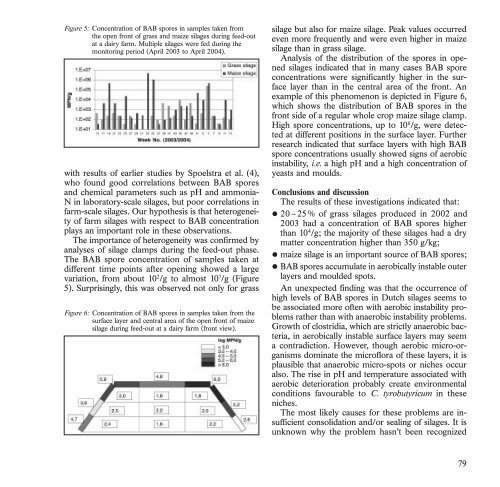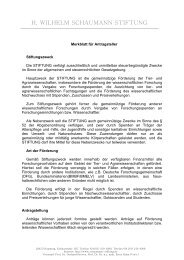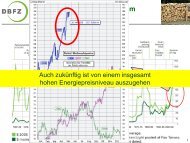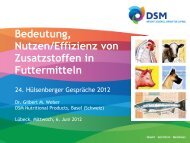Broschüre 2004 zum Download (pdf | 1994,28 KB) - H. Wilhelm ...
Broschüre 2004 zum Download (pdf | 1994,28 KB) - H. Wilhelm ...
Broschüre 2004 zum Download (pdf | 1994,28 KB) - H. Wilhelm ...
Sie wollen auch ein ePaper? Erhöhen Sie die Reichweite Ihrer Titel.
YUMPU macht aus Druck-PDFs automatisch weboptimierte ePaper, die Google liebt.
Figure 5: Concentration of BAB spores in samples taken from<br />
the open front of grass and maize silages during feed-out<br />
at a dairy farm. Multiple silages were fed during the<br />
monitoring period (April 2003 to April <strong>2004</strong>).<br />
with results of earlier studies by Spoelstra et al. (4),<br />
who found good correlations between BAB spores<br />
and chemical parameters such as pH and ammonia-<br />
N in laboratory-scale silages, but poor correlations in<br />
farm-scale silages. Our hypothesis is that heterogeneity<br />
of farm silages with respect to BAB concentration<br />
plays an important role in these observations.<br />
The importance of heterogeneity was confirmed by<br />
analyses of silage clamps during the feed-out phase.<br />
The BAB spore concentration of samples taken at<br />
different time points after opening showed a large<br />
variation, from about 10 2 /g to almost 10 7 /g (Figure<br />
5). Surprisingly, this was observed not only for grass<br />
Figure 6: Concentration of BAB spores in samples taken from the<br />
surface layer and central area of the open front of maize<br />
silage during feed-out at a dairy farm (front view).<br />
silage but also for maize silage. Peak values occurred<br />
even more frequently and were even higher in maize<br />
silage than in grass silage.<br />
Analysis of the distribution of the spores in opened<br />
silages indicated that in many cases BAB spore<br />
concentrations were significantly higher in the surface<br />
layer than in the central area of the front. An<br />
example of this phenomenon is depicted in Figure 6,<br />
which shows the distribution of BAB spores in the<br />
front side of a regular whole crop maize silage clamp.<br />
High spore concentrations, up to 10 6 /g, were detected<br />
at different positions in the surface layer. Further<br />
research indicated that surface layers with high BAB<br />
spore concentrations usually showed signs of aerobic<br />
instability, i.e. a high pH and a high concentration of<br />
yeasts and moulds.<br />
Conclusions and discussion<br />
The results of these investigations indicated that:<br />
•<br />
20 –25% of grass silages produced in 2002 and<br />
2003 had a concentration of BAB spores higher<br />
than 10 4 /g; the majority of these silages had a dry<br />
matter concentration higher than 350 g/kg;<br />
maize silage is an important source of BAB spores;<br />
•<br />
BAB spores accumulate in aerobically instable outer<br />
layers and moulded spots.<br />
An unexpected finding was that the occurrence of<br />
high levels of BAB spores in Dutch silages seems to<br />
be associated more often with aerobic instability problems<br />
rather than with anaerobic instability problems.<br />
Growth of clostridia, which are strictly anaerobic bacteria,<br />
in aerobically instable surface layers may seem<br />
a contradiction. However, though aerobic micro-organisms<br />
dominate the microflora of these layers, it is<br />
plausible that anaerobic micro-spots or niches occur<br />
also. The rise in pH and temperature associated with<br />
aerobic deterioration probably create environmental<br />
conditions favourable to C. tyrobutyricum in these<br />
niches.<br />
The most likely causes for these problems are insufficient<br />
consolidation and/or sealing of silages. It is<br />
unknown why the problem hasn’t been recognized<br />
79











